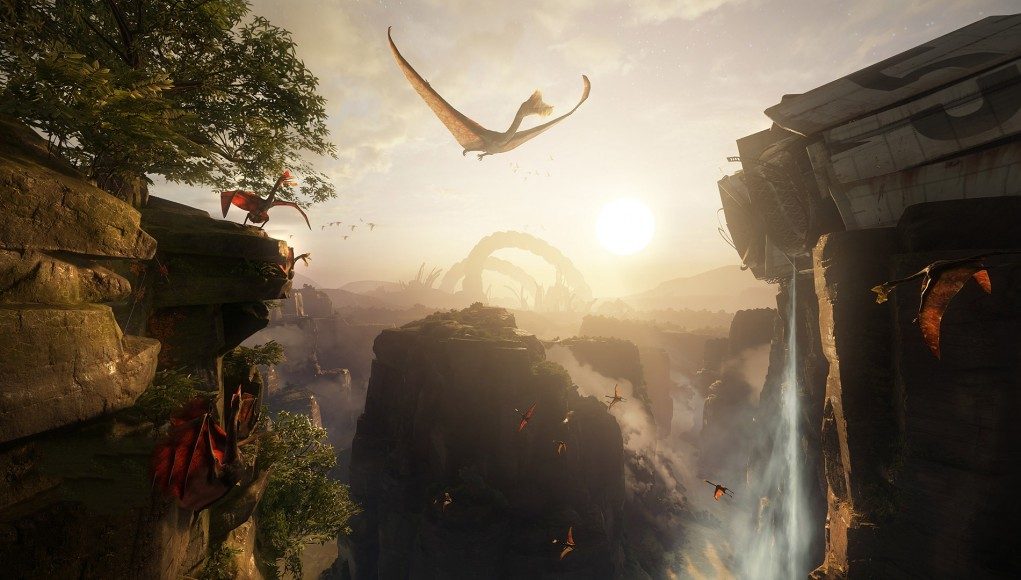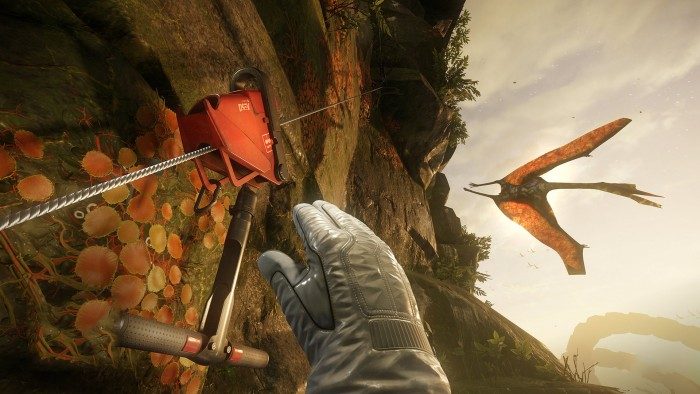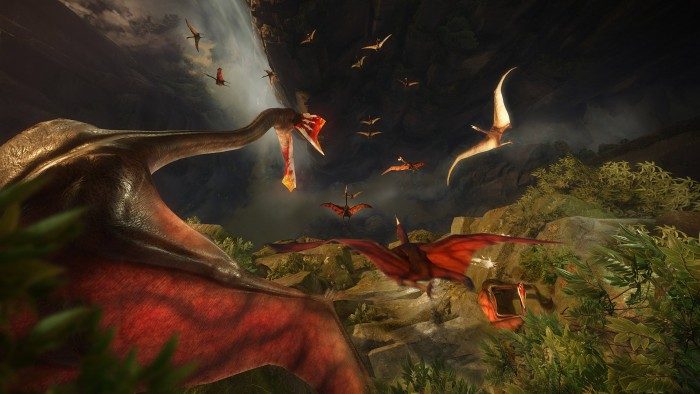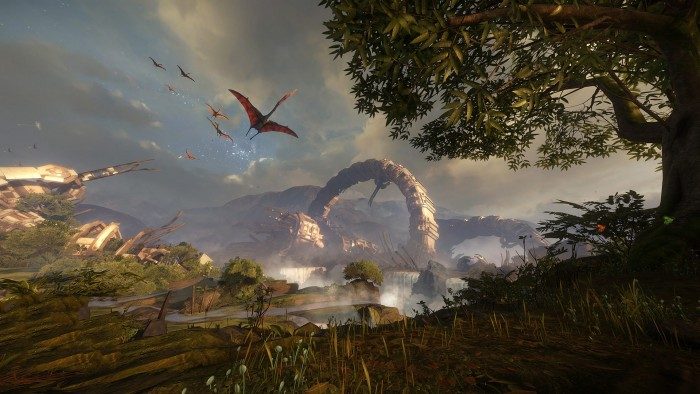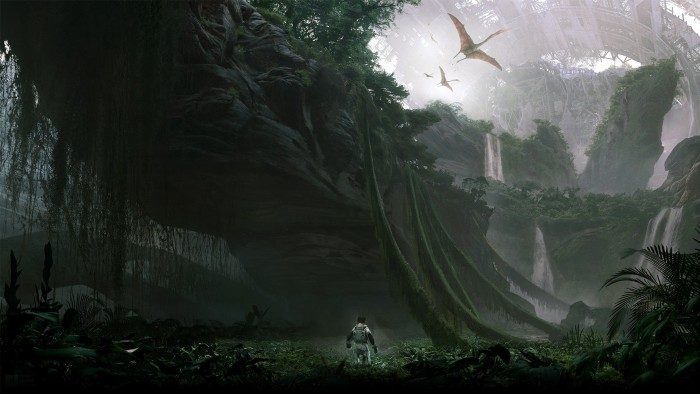With games like Crysis (2007) and Ryse: Son of Rome (2013), Crytek has cultivated a reputation for making beautiful games. The company’s VR team, which just announced Robinson: The Journey as their first title, is keeping with that tradition in full force. Their prototype of the game, shown at E3 2015, is one of the most expansive and visually impressive VR demos I’ve ever seen.
Following the Back to Dinosaur Island VR tech demo from Crytek shown at GDC 2015 back in March, the company is debuting Back to Dinosaur Island 2 this week at E3. Crytek Lead Programmer Dario Sancho Pradel told me that both titles are tech prototypes for Robinson: The Journey, the company’s first VR title. Where the first prototype gave no hints of character, setting, or conflict, Dinosaur Island 2 is the first time we’re getting glimpses into the game’s narrative. And it should be said, the game is stunning—VR at its best.
See Also: Crytek’s 50 Person VR Dev Team Can Only Mean One Thing
I’ve seen a lot of VR demos. I’ve seen a lot of great looking VR demos. But Crytek just raised the bar with the Dinosaur Island 2 prototype. To be fair, they have a leg up with access to the Oculus Rift ‘Crescent Bay’ prototype headset running at a higher resolution and framerate than the prior DK2, and they were running the title on AMD’s just revealed R9 Fury X GPU. Apologetics or not, the company has created a breathtakingly expansive environment that literally made me say, “Wow.”
At the start of the demo I found myself hanging off the side of a cliff within a massive canyon. A waterfall fell from the precipice of a nearby plateau, dropping such distance that it faded into a mist before even reaching the wide rushing river below. The scale of the canyon was awesome in the classical definition of the word—I could see down its corridors for what felt like miles. Crytek has employed expert use of atmospheric perspective, making the river below and distant cliffs feel truly far away.
After spending a few minutes just taking in the gorgeous view around me, I finally realized that the region was also home to unnatural structures. Near the waterfall appeared to be a crashed space vessel of some sort, and further in the distance, rings of a massive structure—maybe a space tether?—littered across the horizon. Some sort of catastrophe seems to have happened here… am I a survivor?
No time for questions. I wouldn’t be much use just hanging about, I had to ascend the cliff. As I turned back from the immense scene behind me, I found myself hanging from a two handed motorized t-bar that was hooked onto a rope anchored above me. With one hand on the t-bar, I was just hanging there; once you place two bars on the bar, the motor engages and begins to winch you along the rope with a satisfying buzz and hum.
I reached the end of the rope after 10 or 15 feet and saw two new t-bars waiting at the anchor point of the first rope. One of the new lines stretched out to the left and one to the right. In order to transition from one t-bar to another I had to let go with one hand, grab onto one of the new t-bars, then follow with my other hand. Careful though… if you let go with both hands at the same time you’ll plummet to your death.
For now, this hand interaction was done using a gamepad where the left trigger controlled the grasping action of the left hand and the right trigger controlled the right hand. Hand positioning was actually done using your head, where you could lean in the direction you want to move your hand and if you were close enough, the hand would grab onto the nearest t-bar when you pulled the trigger. This worked surprisingly well, but screamed out for real motion input.
Dario Sancho Pradel, Lead Programmer on the title, confirmed the obvious: that the team was targeting motion controls. Given that they were demoing on the Oculus Rift Crescent Bay prototype, and that the Oculus Touch controllers have only just been revealed, there wasn’t really an option at this point to bring motion controls to the demo, though I’m fairly certain they’ve cobbled together a solution internally for prototyping the game, as the entire demo seemed well suited for real motion input. Crytek hasn’t said which headsets the game will support, but with ‘the big three’ (Oculus, Sony, and Valve) having all now revealed an official motion input controller (Touch, Move, and SteamVR/Lighthouse Controller, respectively), you can bet that the final title will get your hands into the game.
Anyway… there I was, at this junction of t-bars, with a choice to go left or right. I went left, carefully moving my hands to the next bar, with the motor spinning up to traverse me across the rope as I grabbed on with both hands. As I approached the end of this rope I saw a creature nestled in the cliff just behind some foliage. When I got closer, the creature fell backwards off the cliff like a scuba diver taking their first plunge over the side of a boat. As I tracked the creature’s fall, it expanded its wings and caught the air, quickly turning its fall into flight. I was looking at a huge pterodactyl, orange in color, which swooped back up toward my altitude.
As it passed me I could hear its bird-like shriek and see the sun illuminate the thin membrane of its wings. I could even hear its wings flapping against the air, like a taut sail in powerful winds. Which brings me to another point that should be mentioned about Dinosaur Island 2: the sound design is very impressive. Everything from the waterfall behind me to the pterodactyl’s shrieks echoing throughout the canyon—all of it sounded like it was happening around me within the virtual space, not just coming out of the Rift’s headphones. This is professional sound design with positional audio.
As I continued my ascent along the motorized t-bars I saw many more pterodactyl’s break free from their rest against the cliff and dive into a freefall. The animation and sounds were so well done that I was compelled to watch each one as it tempted gravity for a few moments before stretching out their wings into a glide.
Along one section of rope I came upon baby pterodactyls and let one of my hands off the bar to stop the motor and have a look. I leaned my head up to try to get a peek into what appeared to be a hatchery. Not long after I stopped, a huge pterodactyl however behind me, squawking and squealing, apparently quite unhappy. I feared that if I didn’t hurry along my way, I’d go from a mere observer to part of a baby pterodactyl’s balanced breakfast, so I reached my second hand back to activate the line crawler once again.
As I reached the top of the cliff I was finally able to let go of the t-bar and rest easy. The scene in front of me was just as expansive as the canyon that I’d emerged from, again with wreckage of some unknown massive structure scarring the landscape. As a huge brachiosaurus raised its head just above the edge of my vantage point, a robotic voice told me that we should scan the environment.
Holding both triggers initiated the scan, which sent a blue pulse radiating throughout the environment, marking points of interest as it went along, like a pack of distant brachiosauruses (yes, that’s the proper plural… I had to check), as well as some of the wrecked structures. The points were designated with icons over them which could be further investigated when I held my gaze on them long enough. Once I did that, I would get a bit more info about the points, like whether or not the structures were hospitable (they weren’t). After I scanned and investigated all the available points, the robotic voice informed me that we’d done all that we needed to do here and should move on.
Within the 10 minutes or so of the demo there wasn’t a whole lot of explanation of who I was or what I was doing, but the snippets that I did get with the scans, the robotic voice (an AI, perhaps?), and the dinosaurs left me wanting more, especially with the beautiful environments and well directed action that was superbly suited for VR. I can’t wait until I can take a spin through this demo with real motion controls.
This is one to watch for sure.

